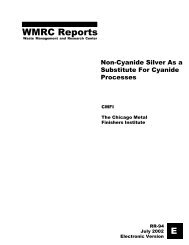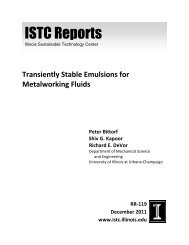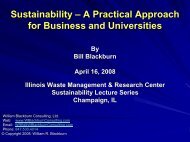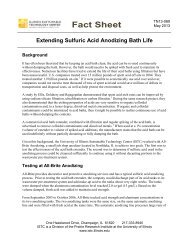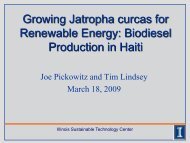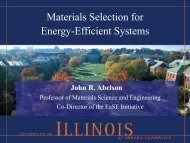Natural Resource Damage Assessment: Methods and Cases
Natural Resource Damage Assessment: Methods and Cases
Natural Resource Damage Assessment: Methods and Cases
You also want an ePaper? Increase the reach of your titles
YUMPU automatically turns print PDFs into web optimized ePapers that Google loves.
<strong>and</strong> translate that into marsh acre-years. They then calculated how long it will probably take the<br />
damaged resources to recover. Texaco then offered to create new marshl<strong>and</strong> so that the present<br />
value of the acre-years of new marsh would compensate for the present value of the acre-years<br />
lost.<br />
To calculate the number of aquatic animals <strong>and</strong> birds killed by the spill, the trustees <strong>and</strong><br />
Texaco agreed to use models to estimate the figure based on the amount of oil spilled, rather than<br />
attempt to count carcasses. They decided not to try to count because it would be expensive.<br />
Moreover, a count would likely be inaccurate because of the difficulty of finding dead animals in<br />
the lake <strong>and</strong> marsh <strong>and</strong> because of the difficulty of knowing whether variations in plankton<br />
counts were caused by the spill or by other factors. In addition, the small number of dead birds<br />
<strong>and</strong> marine animals found during the containment <strong>and</strong> cleanup indicated that the loss of life was<br />
relatively small. The trustees estimated that the spill killed 7,650 kg of marine biomass <strong>and</strong> 333<br />
birds. Texaco estimated that the numbers were significantly smaller. However, because the<br />
trustees found that Texaco’s restoration offer was more than sufficient to compensate for the<br />
high estimate, there was no need to resolve that disagreement.<br />
To calculate the amount of marshl<strong>and</strong> services lost, the trustees <strong>and</strong> Texaco conducted a<br />
joint field study in July <strong>and</strong> October of 1997 <strong>and</strong> in June of 1998. Based on these studies <strong>and</strong> on<br />
observations of the size <strong>and</strong> shape of the oil slick during the containment <strong>and</strong> cleanup, they<br />
divided the damage to marshl<strong>and</strong> into four categories of severity <strong>and</strong> estimated the amount of<br />
marsh in each category. Based on that, they then estimated the amount of acre-years of marsh<br />
services lost to the spill. The total damage to marshl<strong>and</strong> in acre-years was estimated at 75.6.<br />
The trustees determined that human use of the area was not significantly affected, since<br />
alternative resources were easily available during the time the affected area was unavailable, <strong>and</strong><br />
the cost of estimating any loss would probably outweigh the loss itself. The trustees did consider<br />
that there was some loss of human use in deciding on the appropriate compensation.<br />
To calculate how many acres of salt marsh grass Texaco should plant, the trustees<br />
considered several factors, including: the amount of time it would take the planted marsh to<br />
reach maturity, the amount of time it would take marsh grass to grow on the site through natural<br />
colonization, the fact that the grass will be planted in strips so that unplanted areas will be<br />
colonized by the planted grass, <strong>and</strong> the fact that the planted grass will prevent erosion <strong>and</strong> thus<br />
preserve the site. Texaco was required to plant enough grass so that the number of acre-years,<br />
discounted to present value, created on the site through Texaco’s efforts, minus the number of<br />
discounted acre-years that would arise naturally, equals the amount of acre-years of damage.<br />
The trustees calculated that Texaco must plant 18.6 acres.<br />
Settlement: Texaco agreed to implement a restoration project that consists of planting<br />
marsh grasses on 18.6 acres of East Timbalier Isl<strong>and</strong> <strong>and</strong> to pay approximately $480,000 to<br />
cover response <strong>and</strong> assessment costs.<br />
The trustees held public meetings <strong>and</strong> other consultations to consider what restoration<br />
projects would most effectively compensate for the damage. The trustees found that, because all<br />
of the directly affected area, except for 0.28 acres, was recovering rapidly, primary restoration<br />
97



